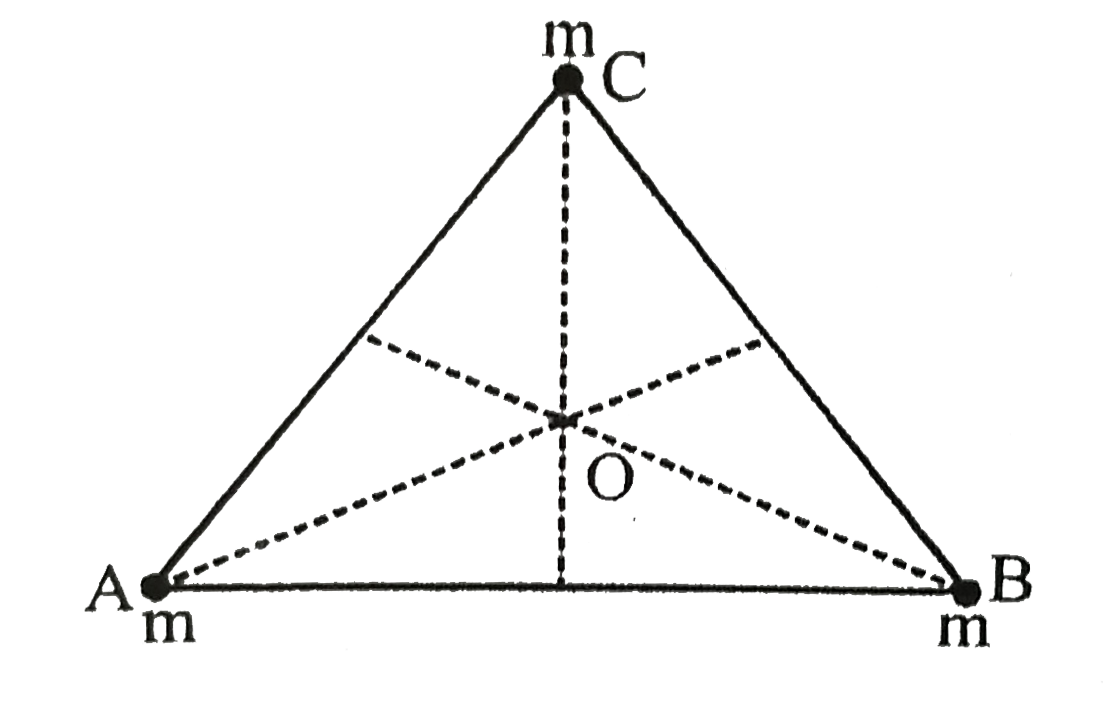Four particles each of mass m are placed at the vertices of a square of side l. the potential at the centre of square is
−√2Gm2l(2−1√2)
−2Gm2l(2+1√2)
−√2Gm2l(√2−1√2)
−2Gm2l(√2−1√2)
The correct Answer is:B
To find the gravitational potential at the center of a square formed by four particles, each of mass m, placed at the vertices of the square with side length l, we can follow these steps:
Step 1: Determine the distance from the center to a vertex
The center of the square is equidistant from all four vertices. We can find this distance using the Pythagorean theorem. The distance r from the center to any vertex (say vertex A) can be calculated as follows:
r=l√2
This is because the distance from the center to a vertex forms a right triangle with half the side length as one leg and half the other side length as the other leg.
Step 2: Calculate the gravitational potential due to one mass
The gravitational potential V due to a single mass m at a distance r is given by the formula:
V=−Gmr
Substituting r=l√2:
VA=−Gml√2=−Gm√2l
Step 3: Calculate the total gravitational potential at the center
Since there are four identical masses at the vertices, the total potential at the center VO is the sum of the potentials due to each mass:
VO=VA+VB+VC+VD
Since VA=VB=VC=VD:
VO=4×VA=4(−Gm√2l)
Step 4: Simplify the expression
Now, we can simplify the expression for the total potential:
VO=−4Gm√2l
Final Answer
Thus, the gravitational potential at the center of the square is:
VO=−4Gm√2l
---
The center of the square is equidistant from all four vertices. We can find this distance using the Pythagorean theorem. The distance r from the center to any vertex (say vertex A) can be calculated as follows:
The gravitational potential V due to a single mass m at a distance r is given by the formula:
Since there are four identical masses at the vertices, the total potential at the center VO is the sum of the potentials due to each mass:
Now, we can simplify the expression for the total potential:
Thus, the gravitational potential at the center of the square is:
Topper's Solved these Questions
- BOOK - NCERT FINGERTPS ENGLISHCHAPTER - GRAVITATIONEXERCISE - Escape Speed7videos
GRAVITATION
- BOOK - NCERT FINGERTPS ENGLISHCHAPTER - GRAVITATIONEXERCISE - Earth Satellite4videos
GRAVITATION
- BOOK - NCERT FINGERTPS ENGLISHCHAPTER - GRAVITATIONEXERCISE - Acceleration due to gravity below and above the surface of earth8videos
GRAVITATION
- BOOK - NCERT FINGERTPS ENGLISHCHAPTER - KINETIC THEORYEXERCISE - Assertion And Reason10videos
KINETIC THEORY
Similar Questions
Find the potential energy of a system of four particles each of mass 2m kept at the vertices of a square of side x. Also find the potential at the centr of the square.
View SolutionFour point charges are placed at the corners of a square of side l. Calculate potential at the centre of square.
 View Solution
View SolutionFind the gravitational potential energy of a system of four particles, each of mass m placed at the verticles of a square of side l. Also obtain the gravitaitonal potential at centre of the square.
 View Solution
View SolutionFour particles each of mass m are kept at the four vertices of a square of side 'a' . Find gravitational potential energy of this system.
View SolutionFour particle of mass m each are placed at four corners of a square ABCD of side a. Point O is the centre of the square. Moment of inertia of all four particles about an axis passing through
View SolutionElectric charges of +10μC,+5μC,−3μCand+8μC are placed at the corners of a square of side √2 m, the potential at the centre of the square is
View SolutionFour particles, each of mass 1kg, are placed at the corners of a square OABC of side 1m. 'O' is at the origin of the coordinate system. OA and OC are aligned along positive x-axis and positive y-axis respectively. The position vector of the centre of mass is (in 'm')
View SolutionFour particles each of mass 'm' are placed at the four vertices of a square 'a' .Find net force on any one the particle.
View SolutionThree identical particles each of mass m are placed at the vertices of an equilateral triangle of side a. Fing the force exerted by this system on a particle P of mass m placed at the

(a) the mid point of a side
(b) centre of the triangleView SolutionFour particles, each of mass m and charge q, are held at the vertices of a square of side 'a'. They are released at t = 0 and move under mutual repulsive forces speed of any particle when its distance from the centre of square doubles is
View Solution

